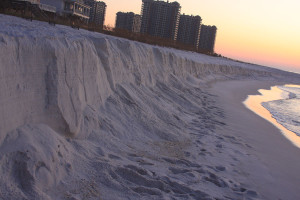
I just spent another week in one of our favorite places, Sarasota, Florida. The weather was great and everyone had a wonderful time. My wife Gail and I lived there from 1978 until 1983, and have been visiting there every year since then. There have been many changes, new developments, buildings, hotels, shopping centers, etc. We have lost many of the old family stores and restaurants to have them replaced by newer fancier ones.
However, by far the greatest change that I see from year to year are the beaches themselves. This year it was even more pronounced due to the effects of Tropical Storm Debbie that swept through the area June 26, 2012. Ten to 30 feet of sand were eroded from beaches in Sarasota County.
Erosion of beaches is nothing new. There has been several attempts to replenish the beach and there is an official presentation on the City of Sarasota’s website about the Lido Beach Restoration.
As much as I love the beach, the fallacy behind any beach restoration or replenishment is that we can “fix” a naturally occurring process, the ever changing relationship between water, wind and sand. According to the Center for Ocean Solutions, coastal erosion is a natural process along the world’s coastlines that occurs through the actions of currents and waves and results in the loss of sediment in some places and accretion in others. Erosion is considered to to be sporadic and episodic. There can be large scale erosion in only a few hours with a severe storm (episodic) and different areas can erode at different rates even during the same event (sporadic).
Here are examples of erosion in the Florida Panhandle at Navarre Beach due to two hurricanes. The upper photo was taken on July 17, 2001, the middle photo was taken on September 17, 2004, one day after the landfall of Hurricane Ivan, and the lower photo was taken on July 12, 2005, two days after the landfall of Hurricane Dennis. This is a clear example of the episodic nature of beach erosion. (Click image to enlarge)
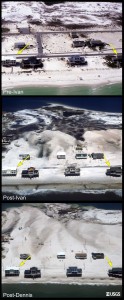
Scientific American stated in its EarthTalk column that coastal erosion in any form is usually a one-way trip. Man-made techniques such as beach nourishment—whereby sand is dredged from off-shore sources and deposited along otherwise vanishing beaches—may slow the process, but nothing short of global cooling or some other major geomorphic change will stop it altogether. U.S. Environmental Protection Agency estimates that between 80 and 90 percent of the sandy beaches along America’s coastlines have been eroding for decades. In many of these cases, individual beaches may be losing only a few inches per year, but in some cases the problem is much worse.
According to Stephen Leatherman (“Dr. Beach”) of the National Healthy Beaches Campaign, building a bulkhead or seawall along one or a few coastal properties may protect homes from damaging storm waves for a few years, but could end up doing more harm than good. “Bulkheads and seawalls may accelerate beach erosion by reflecting wave energy off the facing wall, impacting adjacent property owners as well,” writes Leatherman, adding that such structures along retreating shorelines eventually cause diminished beach width and even loss.
Other larger scale techniques like beach nourishment may have better track records, at least in terms of slowing or delaying beach erosion, but are expensive enough as to warrant massive taxpayer expenditures. Beach nourishment is the process of adding new sand to the beach profile in order to restore it to some former width. This is usually accomplished by dredge and fill operations with sand pumped onto the beach from an offshore source, such as sand bars or shoals. Beach nourishment is only feasible at the community level as large sectors (e.g., miles of the shore) must be nourished to be economical viable. In the early 1980s, Miami Beach was restored at the cost of $65 million along this 10-mile strand of shore.
There have been over 8 beach nourishment projects on Lido Beach at a cost of over $12 Million Dollars. However, the beach continues to erode. Here are pictures I took last week showing significant recent erosion on Lido Beach.
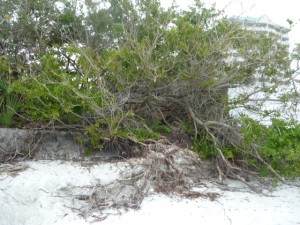
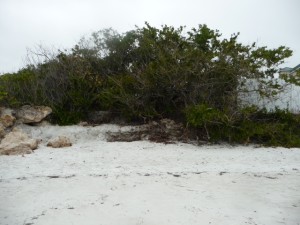
With the expected rise in sea levels and the increase in both the frequency and severity of storms being attributed to global climate change, one can expect that coastal erosion will continue to increase. The U.S. government’s Environmental Protection Agency states that if sea levels increase by one foot, would erode most of Florida Beaches 100 to 200 feet. They also believe that sea levels could rise as much as 3 feet over the next 100 years. The cost to replenish the lost sand would be $8 Billion.
While it is understandable that areas with expensive homes and condominium projects and whose economic base is dependent on tourism will continue to spend large sums on beach replenishment projects. While this may be futile in the long run, short term it still allows for a wonderful beach experience as these photos from last week will show.

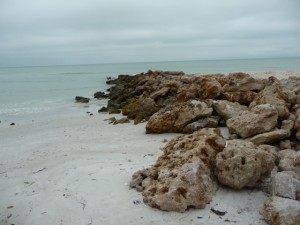
Also, if you didn’t click the “sand” link earlier in the article, take a second to check out this cool slideshow. It gets up close with what our beaches are made out of, Sand of course!
Click here to view the slideshow.
![]()
